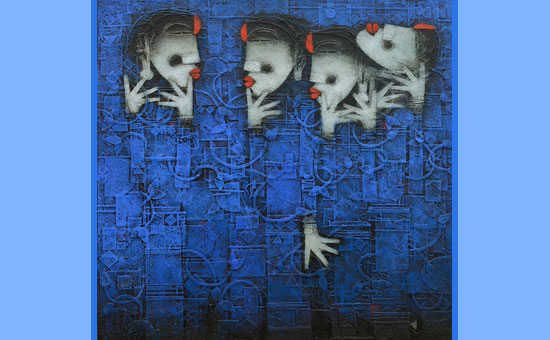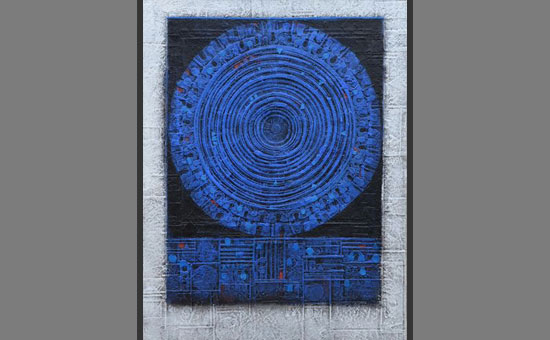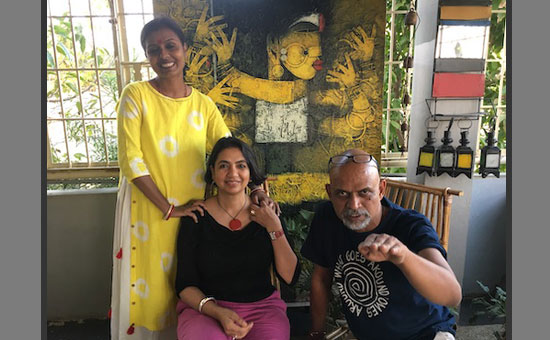- Sonia Nayyar Patwardhan, the curator and founder of Laasya Art gallery in Palo Alto, California, recently interviewed contemporary
Indian artist Basuki Das Gupta about his unique mixed media paintings.
Basuki Das Gupta
is a river of a man. He is one of the most multi-talented people I know, as he
is not only a leading contemporary Indian artist but also a theater actor, a
composer of music, a singer and a skilled musician of multiple instruments. A
free spirit, he lives life on his own terms and that has given a striking depth
and vibrancy to his artworks.
I recently interviewed Basuki so that he could explain his unique practice in his own words, as I have been so lucky to get to know him by showing his work at my gallery Laasya Art. He generously shared his life’s story and the process behind his evocative mixed media paintings.
 Shakti - Divine feminine power,
Mixed media on canvas, 30 x 30 inches.
Shakti - Divine feminine power,
Mixed media on canvas, 30 x 30 inches.
Sonia: Basuki, what
does art mean to you?
Basuki: It’s oxygen for me. It’s like breathing — if I don't make art, then I am not breathing, it feels like I am suffocated.
The
process of creating your mixed media paintings is very interesting, as you
often incorporate newspapers, fennel seeds and fevicol. Can you speak more on
that?
First,
let me tell you why I use these materials. I was born and brought up in
Bishnupur, West Bengal, surrounded by terracotta temples. In the corridors of
those temples, I was always touching the paintings and murals on the walls,
when I was crying or happy. Maybe it helped me to overcome all those moments of
crisis that I went through. So whenever I touch my own paintings now, all my
childhood emotion comes back.
When I am painting, texture is my first priority. It’s a very physical experience. I use paper pulp, texture white and many other things like cloth. ‘Texture white’ is a type of resin used by artists, which keeps the canvas from absorbing paint. The colors will feel dull without it — it’s like providing resistance.
Describe your journey to me, from teaching in Tumkur to where you are today.
I was living in
Kolkata wanting to be an artist, to be part of theater and music too. But it is
a big city with a lot of people aspiring to be artists of different forms.
There was no space for newer ones.
 Blue Sun, Mixed media on canvas, 48 x 36 inches.
Blue Sun, Mixed media on canvas, 48 x 36 inches.
Then I got an opportunity to come to Tumkur, which is a huge place with hills and rocks, a vast spread of sky. I prefer to stay in a place like this, so I started liking Tumkur. My salary was low but the school was fantastic. I was appointed as a visual arts teacher but I experimented with other subjects, integrating science and art, history and art, literature and art. For example, we had ‘ancient Egyptian day’ where we replicated the architecture, clothing design, food habits and market places. Students didn’t realize that they were actually learning about history!
I was so happy with the school that I never thought that I would be a professional artist. But when my daughter was born, there was a turning point where I realized that I needed to earn some money. So these financial insecurities forced me to begin making and selling art again. I would go to the city in the hope of getting at least two or three thousand rupees extra. Initially it was difficult, there was no money to buy food for my daughter, but ultimately it was an opportunity. My wife is very supportive - for five years, she didn’t buy any clothes or luxuries for herself.
After two failed
exhibitions, I finally had a successful show and began to achieve something as
an artist. Suddenly I earned 2 lakh, around 2006, and it was such a huge amount
that my wife was worried for me to go home alone by bus. So she and my little
daughter came with me. I carried one lakh each safely in both my pockets. When
we think of it now, those adventures were fun.
It sounds like your
wife has played a big role in your success as an artist.
 Artist Basuki Das Gupta and his wife,
Madhumitagupta, with the author seated in center, smile in front of a recent
painting.
Artist Basuki Das Gupta and his wife,
Madhumitagupta, with the author seated in center, smile in front of a recent
painting.
I began to do something constructive in my life because of my wife. I had a very ‘take it easy’ attitude. Something is coming my way, something is going... There was no idea of settling down, of doing something constructive. I used to paint and draw on paper but never maintained it. My wife brought order into my life.
We
are looking to get you to the US, for a show and talk at Laasya Art. How are
you feeling about that?
I'm a bit nervous actually! I have traveled abroad only once, to Thailand which is similar to India. The moment you asked to come and have an exhibition in California, I asked my wife to come with me. If she is not there, then I might be nervous. But I am excited and confident also.
Thank
you, looking forward to having you here!
It is particularly powerful to me how Basuki’s personal story shines through his artwork. His immense love and appreciation for his wife, for instance, is clearly expressed in his original paintings of independent and self-assured women. His Ipshita series encourages positivity and confidence in women, while his paintings of Goddess Durga, who is revered in his home state of West Bengal, celebrate her feminine strength and power. His newest abstract series also explores influences from his countryside upbringing, such as the sun temple at Konark or elements of nature like waves, sunflower and the sun itself.
I find such inspiration in Basuki’s path from selling paintings on the side to exhibiting in galleries internationally — making a living and achieving recognition as an artist is certainly difficult, but great art somehow finds a way to persevere.
To read
all articles by author
All
pictures by Basuki
Das Gupta. To see pictures
of Bishnupur-Terracota Temples where Basuki was born.
DISCLAIMER AND
CREDITS: All images are reproduced here courtesy of the artists and Laasya Art
gallery, Palo Alto. They may not be reproduced elsewhere without written
permission from Laasya Art.